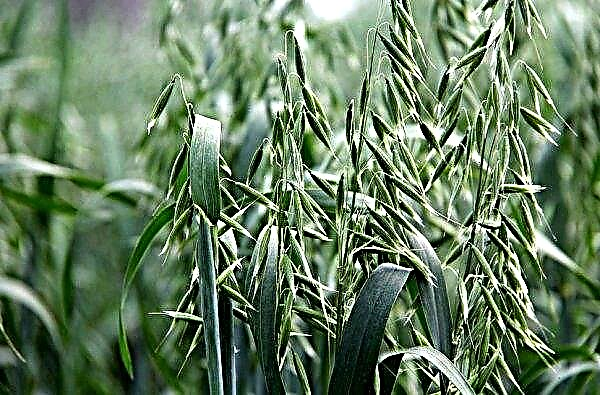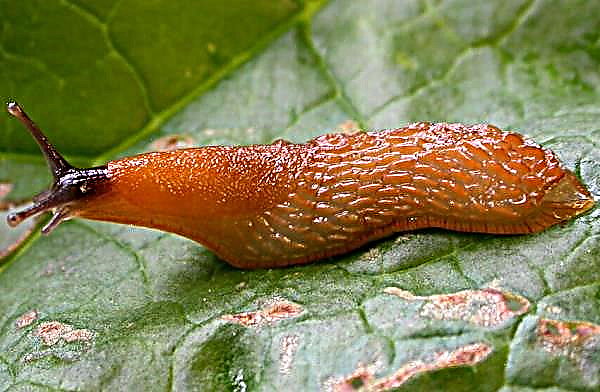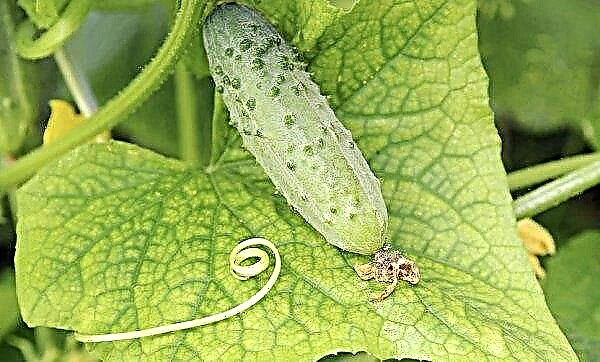Ficus Benjamin belongs to the evergreens, because of which it is often placed both in residential premises and in office interiors. However, its appearance deteriorates significantly when the leaves fall off the plant. For what reasons this happens, how to correct the situation or even prevent leaf fall at the indoor tree, you will learn from this article.
In which cases you should not be afraid
Despite the fact that it is not peculiar to Benjamin's ficus to discard leaves and change their color, there are situations when the leaf fall does begin and at the same time is not a sign of a disease or damage to the plant.
Initially, you need to pay attention to the abundance of leaf fall. If the flower loses about 10-15 leaves a year, do not worry - this way it gets rid of old leaves, and then overgrows with new ones.
Did you know? The life expectancy of ficus leaves is on average up to three years.
If the tree massively loses leaves and changes their color, then it is necessary to analyze the conditions of plant maintenance and care for it. A sharp change in the appearance of the indoor tree indicates his poor health.
Why do the leaves of ficus Benjamin turn yellow
To understand how to restore health to an evergreen plant, it is initially worthwhile to find out the cause of yellowing of the leaves and, if possible, eliminate it. Often, to return Benjamin's ficus to a healthy appearance, it is enough to change the conditions of its maintenance, the composition of the soil, the watering regime, or simply move the tree to another place.
Irrigation
If the plant receives too much moisture, the ends of its leaves begin to dry out, and the leaves themselves turn yellow.
Important! To determine if you need to water the ficus, we recommend immersing your finger in the earthen mixture. If it remains dry, then the plant needs watering. Otherwise, water procedures can be postponed until the next day.
Watering is required depending on the room temperature. In the hot season, the plant will need frequent watering, in the cool - less. It is worth watering the earth every two to three days, and in the intervals between watering, loosen the soil so that more air gets into it. It is important not to touch the roots of the tree.
Excess moisture in the soil often causes fungal diseases and even rotting of the rhizome, which often leads to the death of ficus. If you are not sure that the plant needs another portion of water, wait a while with watering - ficus better tolerates a temporary lack of moisture.
We also recommend that you pay attention not only to the frequency of irrigation, but also to the quality of the water. It is desirable to supply ficus with settled water at room temperature. To get rid of excessive rigidity, you can boil water, let it cool and then use it for irrigation.
Inappropriate location
Ficus owners know that these plants can react quite sharply to a change of residence. Sometimes the trees drop their leaves immediately after buying and installing a pot in a new house. To restore Benjamin's ficus to health, you need to put it in another place and observe its behavior.
Important! Having chosen the optimal place for the ficus, in which it will acquire a healthy appearance, do not disturb it with subsequent permutations.
Ficuses can react with yellowing of leaves or their falling off even after rearrangement in the walls of one house, however this refers to the individual sensitivity of each plant. Some representatives of Benjamin's ficuses tolerate movements both around the house and around the city or country quite calmly and painlessly.
The amount of lighting that the tree receives also matters. Ficuses are photophilous, so you need to position the pot so that a sufficient amount of sunlight is exposed to the plant. If this is not possible, you can place the ficus in partial shade.
The lack of ultraviolet radiation leads to the fact that the crown of the indoor tree changes color and becomes yellowness. In order to return ficus liveliness, it is enough to place it in a lighted place.
Non-compliance with the conditions of detention
Ficus Benjamin is not too whimsical to living conditions, but do not neglect his needs. Indoor tree reacts sharply to low air temperature, so it is necessary to maintain an optimal rate of + 18 ° C and above.
Important! Drafts from warm air will endure Benjamin's ficus without consequences. The danger is only cold air masses.
Also, the plant does not tolerate cold drafts and a sharp change in ambient temperature. All this affects the health of the flower, in particular, the condition of its leaves.
Land depletion
The long-term presence of ficus in the same soil also adversely affects its appearance. Once a year, a young tree needs to change the soil, and replace the capacity with a larger one, since the roots of young ficuses grow quickly and they need more space. Adult plants can be transplanted less often - once every two to three years.
This is done because the earth in the pot has limited resources in the form of useful substances. That is, the indoor tree for several months uses all the trace elements that the soil possessed, and after that it remains to grow in depleted soil. To saturate the soil, you can use top dressing, but the best solution is to transplant a tree.
Thus, the roots will receive enough space and will be able to get all the necessary trace elements for a healthy life.
Pests
If you notice a sharp yellowing of the crown of the plant, then you need to examine the back of the leaves. The presence of a small web on it indicates that the pest was visited by such a pest as a spider mite.
Important! Pest control of indoor plants due to folk methods is not always effective. To surely get rid of them, you need to turn to chemicals, insecticides.
Also on the back of the leaves you can find thrips - a small insect that is not capable of active reproduction, however, several such specimens are enough to harm the indoor tree.
What to do and how to treat the plant?
To return Benjamin's ficus to a healthy appearance, you need to find out the reason for the yellowing of the leaves. After that, you can act on the basis of the information received.
If the plant has a lot of water, then it is required to regulate the irrigation regime. If necessary, you can replace the earth in a pot in order to protect the tree from decay and the appearance of fungal infections.
With insufficient lighting, you need to change the location of the evergreen: put the pot where it gets more UV light. If this is not possible, it is worthwhile to periodically spend a bath in the indoor tree; at other times, it can exist in shady areas.
Did you know? A variety of Benjamin is the most common representative among ficuses. It can also be found under the names "birch ficus" or "benjamin".
Pests can be eliminated by treating the plant with an insecticide.
If you did not take into account one of the conditions of plant maintenance, you must change the habitat of the flower: increase the air temperature to the level of + 18 ° C, conduct a timely tree transplant, and feed the soil with useful substances.
Benjamin's ficuses are resistant to infections, but they can also get sick. Among the diseases, anthracnose and cercosporosis are distinguished - both of these diseases belong to fungal infections. You can determine a diseased plant by the presence of foreign spots on its leaves.
To cure a houseplant, you need to rid the tree of damaged parts, that is, cut leaves with spots. The next step to recovering the tree will be treating the plant with fungicides.
Preventive measures
The best way to prevent yellowing of Benjamin's foliage will be proper care for him, as well as compliance with the living conditions of the flower. Thus, you minimize the possibility of changing the color of the foliage and keep your green tenant healthy and attractive appearance.
A moderate amount of moisture, enough light, soil saturated with nutrients, timely transplantation and optimal ambient temperature will be the best helpers in maintaining the health of ficus Benjamin.
Extra Care Tips
In addition to the usual rules for the care of Benjamin's ficus, there are some features when caring for this flower.
For example, once every four months it is advisable to carry out water procedures for the tree. To do this, put the pot with the plant in a bathtub, cover the earth with a film so that the soil does not become excessively moist, and water the plant with warm water.
With the help of such a soul, you will save the evergreen tree from the dust accumulated on the leaves and trunk. It is also highly recommended to collect rainwater, so that after spraying it with a room tree.
In order for all the leaves to receive the same amount of ultraviolet radiation, it is necessary to periodically change the position of the pot relative to the sun and turn it. If your indoor tree belongs to variegated, you should make sure that over time, the bright color of the crown does not change monophonic. To do this, periodically check the crown for the presence of monochrome leaves.
If your indoor tree belongs to variegated, you should make sure that over time, the bright color of the crown does not change monophonic. To do this, periodically check the crown for the presence of monochrome leaves.
Having discovered such leaves, it is necessary to get rid of them, since they tend to grow rapidly, which subsequently leads to a change in the color of the crown from variegated to monophonic.
Did you know? The milk juice of the plant described is latex of natural origin, so it is not recommended to install Benjamin's ficus indoors if residents or employees are allergic to latex.
Summing up, we can confidently say that the yellowing of the leaves of ficus Benjamin is not always a signal of the poor health of the flower.
However, if this still happened, observe your indoor tree and analyze your actions for caring for it - in most cases, it is improper care that causes the leaves to become yellow.












